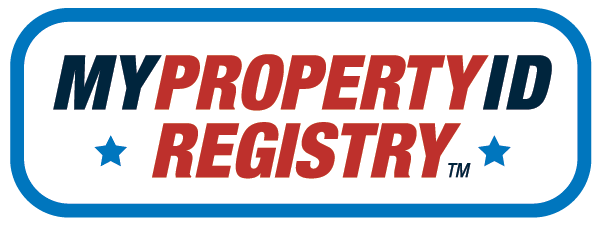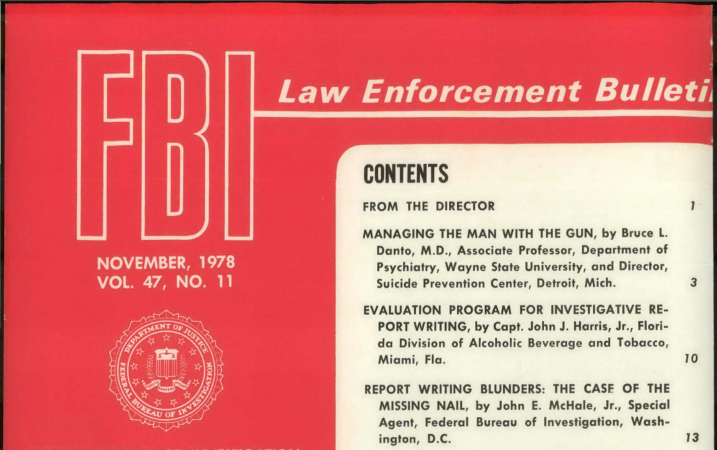NOTE: The following text is a duplicate of an article appearing in the FBI Law Enforcement Bulletin. November 1978, pages 23 to 25. In its transcription, there may be minor errors. The goal of posting this article is to allow search engines a cleaner version to scrape.
FBI Law Enforcement Bulletin – November 1978 — LEB
At the time of its publication, William Webster was the Director of the FBI.
William H. Webster – Wikipedia
National Committee on Operation Identification Prescribes Basic Standards
A National Law Enforcement Committee established by the National Sheriffs’ Association (NSA) and the International Association of Chiefs of Police (IACP), two organizations representing nearly all of the State, county, and municipal law enforcement administrators, has recently completed the first phase of its attempt to provide a workable solution to the problems associated with the identification and return of stolen property.
Since July 1977, representatives of the Federal Bureau of Investigation, the National Crime Prevention Institute, the National Conference of State Criminal Justice Planning Administrators, and the Criminal Division of the U.S. Department of Justice have met on several occasions with representatives of the IACP and NSA in Washington, D.C., to discuss possible solutions to the problems. (See, FBI Law Enforcement Bulletin, Vol. 46, No. 11, pp. 1-2.)
FBI Law Enforcement Bulletin – November 1977 — LEB
As an initial task, the committee examined the feasibility of developing a standardized owner-applied numbering system for use in a nationwide property identification program. Such a program has often been suggested as a means to facilitate law enforcement’s return of lost/stolen property to its rightful owner(s). During the committee’s review of existent property identification programs, it became readily apparent that there are both a number of programs and a variety of owner-applied numbering systems in use throughout the country. It was also quite clear that there has been little effective coordination between jurisdictions in the selection of numbering system(s) and in the development and implementation of property identification programs.
Despite the number of existent owner-applied numbering systems which provide citizens with a permanent, personal, and traceable identifier, no one system appeared to the committee to be readily adaptable for nationwide use. This conclusion was based largely upon the committee’s realization that a number of factors, which vary widely from one jurisdiction to another, must be taken into consideration in the selection of a numbering system. In addition, there are a number of economic and political considerations which preclude the development of a standard, national system of personal identification and/or the creation of a national repository for such information at this time.
Among those considerations are the following:
- Initial costs of establishing such a system would undoubtedly be substantial;
- Effective administration of such a system would require the establishment of a complex and costly bureaucratic structure; and
- Many citizens would view such a system either as a potential threat to their privacy or as a violation of their civil rights
Although not in favor of the establishment of a national property identification program, the committee has concluded that both locally and privately administered property identification programs can contribute greatly to law enforcement’s ability to return lost or stolen property to its rightful owner. Based upon its study of existent programs, the committee identified the following characteristics of an effective property identification program.
- An owner-applied property identification number must be universally RECOGNIZABLE by the public and law enforcement.
- An owner-applied property identification number must be interjurisdictionally TRACEABLE—any law enforcement officer must be able to use the number as a ready and continuing means to establish the identity and current whereabouts of an individual property owner.
- It is of great importance for an owner-applied property identification number to be TRACEABLE and RECOGNIZABLE not only within the jurisdiction in which the property was marked but in other jurisdictions as well.
- An owner-applied property identification number must be a UNIQUE personal identifier—no two individuals may have the same identifier.
- An owner-applied property identification system should be SIMPLE. The extent of citizen participation and system effectiveness can be directly related to a program’s utilization of existing community resources, and its satisfaction of user needs, i.e., for confidentiality, accessibility, etc., and
- An owner-applied property identification system should be FUNCTIONAL. Utilization of a personal identifier which is compatible with requirements established for entry of a stolen article in the National Crime Information Center’s (NCIC ) Stolen Article File is recommended.
To assist a police officer both in the recognition of an owner-applied number and in tracing ownership of the property, the committee recommends that owner-applied number utilize prefix and suffix abbreviations which identify the marking jurisdiction and the type of identifier system being used. For example, the prefix ” CA” and suffix “OLN,” when added to the number NOO11440 in a sequentially standardized format (CA/NOO11440/OLN), make the number readily recognizable to a police officer as a California driver’s license number, and potentially traceable to the owner, dependent upon the internal efficiency of the local system and the uniqueness, currency, and permanency of the identifier in use. Similarly, the number DCMPDOOO/123456 would be recognizable as a property identification number, potentially traceable with the assistance of the Washington, D.C., Police Department to the owner. In the former example, the prefix and suffix are accepted abbreviations for the State of California operator’s license number, and in the latter example, DCMPDOOO is the NCIC code for the Metropolitan Police Department, Washington, D.C. Adoption of a nationwide uniform prefix, such as “OI,” by systems not employing the NCIC State and local alpha prefixes would also serve to facilitate nationwide recognition of a number as an owner-applied property identification number. However, some provision for identifying the specific system would be required for tracing purposes, e.g., registration of a system identifier with a central, although private, repository generally known and referenced by the law enforcement community.
Some number systems employed in property identification programs are not permanent; those based on phone directories, zip codes, or other forms of cataloging individuals which are subject to change over time are examples of this shortcoming. In addition, drivers’ license numbers used in some States, which are subject to reissuance to another individual when the original holder changes address, license status, and/or surrenders the license, are not traceable identifiers for purposes of property identification.
Although there are a number of unique personal identifiers available for use in property identification systems, many are not retrievable or cannot be traced after passage of a short period of time, due to their failure to maintain current records. Social security numbers are readily recognizable and for the most part constitute a unique personal identifier. However, the identity of the holder of a social security number will not be released by the Social Security Administration in most instances, and therefore, cannot be traced by law enforcement personnel. Some jurisdictions effectively employ the social security number in their property marking program by using a local data bank to store and retrieve the identity of social security number holders who have participated in the program. In such instances, it is very important that other agencies are able to identify the data-storing jurisdiction in order to assure tracing of owners by law enforcement officers throughout the country.
NCIC now permits the entry of stolen property in its Stolen Article Files on the basis of an owner-applied property identification number.* This change in NCIC policy has provided a means to identify stolen property marked with a personal identifier, if the property has been reported stolen to police, and if it has been entered in NCIC. In order for a property identification number to be enterable/searchable in NCIC, it must consist of no more than 20 letter/number characters.
The relative utility and simplicity of a property identification number can contribute greatly to the effectiveness of a program. If a property identification number is easy to acquire, and essential for purposes other than property identification, citizen participation in the program will be greatly enhanced. Similarly, recruiting activities in a property identification program are more productive when citizens understand how the property identification number was selected and why it will prove to be, or has been, an effective personal identifier.
Many jurisdictions have found that utilization of an existing unique number system, for example, a driver’s license number, tax number, voter’s number, etc., has enabled the jurisdiction to avoid the creation of a new recordkeeping system and to avoid problems associated with maintenance of such a system. However, any jurisdiction planning the adoption of such existing numbering systems should first consider their permanency and ubiquity.
The committee strongly urges that jurisdictions administering or considering the adoption of property identification programs evaluate their numbering system in light of the foregoing criteria and strive to attain these minimum standards of effectiveness and efficiency.
The committee shall continue to seek out information and suggestions from law enforcement administrators, business, industry, and citizen groups, and to analyze current programs and systems for the purposes of identifying problem areas, discerning the most effective existent practices, and formulating minimum acceptable criteria for a nationally uniform system. Areas to be examined include: Strategies for promoting, facilitating, and maintaining citizen participation; techniques for employing OI as an investigative tool; and procedures for marking, registering, and inventorying personal property, etc. To assist local and State law enforcement agencies to adopt—or adapt—their program to the identified uniform standards, the National Committee on Operation Identification anticipates seeking financial support to facilitate the development, publication, and dissemination of written guidelines and the provision of follow-up training and technical assistance to local OI projects. The committee shall also solicit the assistance of the National Media Campaign on Citizen Action Against Crime to convince citizens to participate in local property marking programs.
*The NCIC participants at their March 1978 meeting voted to extend the OAN capability to the Stolen Vehicle File, especially to assist in indexing that property found in the construction and farm industries. Approval of the concept to implement the application had been obtained from the NCIC Advisory Policy Board in June 1978. With the eventual implementation of this application, all property (except license plates, guns, and securities) marked with an OAN will be eligible for entry into NCIC when stolen.



